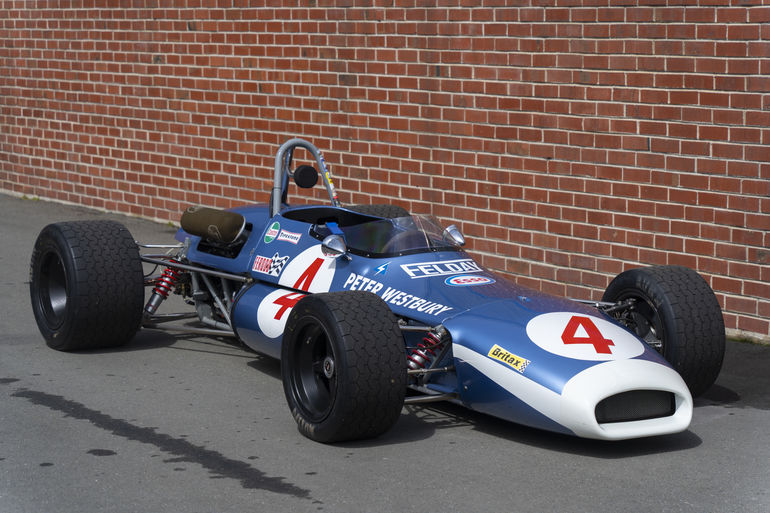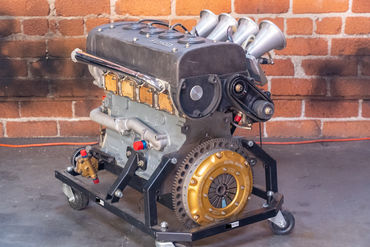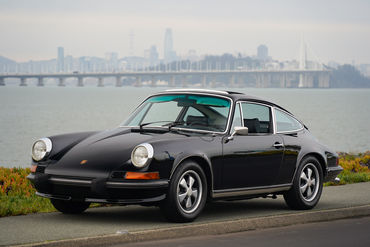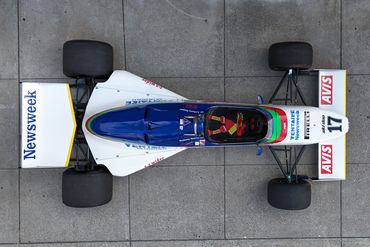Sold
SOLD 03/23
1969 Brabham
BT-30 Formula 2
Ex-Peter Westbury. Beautiful "cigar era" center seat Formula 2 racer. Accompanied by 2 spare engines, both fresh, among other spares. No expense spared preparation by J&L Fabrication.
- VINBT30/3
- Exterior ColorLight Blue
- Interior ColorBlack
- MileageTMU
- Engine1600cc DOHC Inline 4 Cylinder
- Transmission5-Speed Hewland Transaxle
- StatusSold
- StockFJ2613
Description
1969 Brabham BT30 Formula 2
Chassis No. BT30/3
Blue and White “Peter Westbury” Racing Livery
Among the finest constructors of the golden age of motorsports racing, Brabham set the standard for many competitors that would emerge during this period of exemplary driver courage and clever engineering innovations. Officially known as Motor Racing Developments Ltd., a UK company founded in 1960 by Australian Jack Brabham and Ron Tauranac (the B and T initials designated their names and were stamped into each chassis), the team would develop a series of historically important racecars leading up to the BT18 model. In 1966, a remarkable six years after opening their shop, Jack Brabham piloted the BT18 to win his first of four Constructors’ World Championships. An amazing achievement for any driver piloting a car of his own construction.
After BT18 construction, Brabham would go on to become the largest manufacturer of open-wheel race cars, building more than 500 cars by 1970 including race cars that won championships in Formula Two and Formula Three, competed at the Indy 500, and in Formula 5000 racing. Prodigious innovators, Brabham cars were pioneers of carbon brakes, hydro-pneumatic suspension, and in-race refueling while also developing cars with unique ground effects, unusual cooling systems, and being one of the earliest builders to use turbocharging in their cars.
Originally derived for the 1969 racing season, a new range of single seaters established the B28 (F3), the B29 (FB), and the B30 for F2 classification races. All three cars utilized newer, more sophisticated space-frame construction, which would prove to be labor intensive to build, delaying output for the season. Utilizing conventional suspension and outboard brakes, Brabham produced 26 BT30s for the 1969 and 1970 racing season, all of which were piloted by privateers as Brabham did not field a factory team or “works” car during this period. Proving to be highly successful with many podium finishes, the BT30 was reliable, durable, and easy to set up to meet a range of various track requirements.
This example is chassis #3 of 26 BT30s constructed for the 1969 and 1970 racing seasons. Delivered new to Peter Westbury, the racing history for 1969 includes numerous entries including Westbury driving this very car in the 1969 German Grand Prix – Deutschland Trophae. BT30/3 is documented with a copy of the 1969 F2 register listing Peter Westbury in the drivers table of contents and further listing each of the many races from the 1969 season, beginning with the inaugural race April 7, 1969, at Thruxton. Subsequent races continue in the listing through the full 1969 European F2 season.
In these listings. Westbury shares the starting grid at Monza, Hockenheim, and Zolder going shoulder to shoulder in this car against legendary drivers Jackie Stewart, Graham Hill, Derek Bell, and Jochen Rindt to name just a few. Westbury would achieve a First-Place finish at Neubiberg driving this car in October 1969 in addition to his Grand Prix start in this car at the 1969 German Grand Prix. As a highly regarded driver, during his career Westbury held two British Hillclimb Championship titles, became a highly successful Formula 3 racer, and gave future sports car great Derek Bell his break in international motorsports.
After Westbury’s ownership, BT30/3 was sold to John Wingfield who used the car in Formula Libre and selected F2 events for 1970 and 1971. The next owner was Jim Charnock (Liverpool, UK) who raced it extensively in Formula Libre, completing the end of the 1975 season. Races and ownership history from 1975-1984 have yet to be uncovered, but in 1984 the car was advertised for sale by Brian Classic. In 1985 the car was sold to Chris Mann (UK) and then sold through Frank Snyder to Ray Delaney (Melbourne, Australia) in 1987. Delaney would go on to race the car for the next six years in east coast Australian historic events including races at Calder Raceway (Victoria), Sandown Park (Victoria), Oran Park (New South Wales), Amaroo Park (New South Wales), Winton Raceway (Victoria), and participate in support races at the Australian Grand Prix in Adelaide, South Australia in 1988 and 1989. Dick James purchased the car in 1993, followed by Mike Carmody in 2003 who then sold it to the current owner, a highly regarded North American-based vintage race car enthusiast and collector, in 2005. The current owner restored the car to a very high standard from 2005-2006, returning it to the original Westbury livery as shown today.
Supported by logbooks dating back to 1987 and service invoices including copious restoration invoices dating back to 2005, the past 17 years of ownership have been devoted to preparing the car for historic events and maintaining the highest level of both mechanical and cosmetic preparation possible for a car of both historic and performance merit. Over a hundred individual detailed invoices outlining itemized expenses and mechanical services performed by race car experts at J&L Fabrication, Puyallup, WA who are highly regarded in the industry for building fast cars, bolstered by a top-tier team of professionals specifically skilled at prepping race cars. The invoices convey the level of detail the owner and the professional race-prep team at J&L Fabrication have lavished on this historically important BT30. The owner estimates that the engine and gearbox currently installed in the car have approximately four hours of run time.
Recently invoiced J&L Fabrication mechanical preparation from 2021 and 2020 include servicing the manual fire bottle, new battery, repair and re-install the exhaust header, and check/top fluid levels. Further recent work on the car includes services in 2018 when a fresh set of front and rear Avon tires were installed, Indy gears installed, and a lifeline zero 1.5kg fire system was installed. Also at this time, a complete nut and bolt for suspension and brakes was performed, transmission, and motor mounts were installed, brake and clutch lines flushed, fuel drained and filled, and complete race prep performed. In late 2016 and 2017 the engine and gearbox were removed, the engine refurbished with new gaskets, cleaning, repairing threads, servicing the cooling system, and dyno testing the chassis. Additional work included mirror polishing the header and tail pipes, fitting new seat belts, installing and aligning the clutch, and installing hydraulic lines. In 2011 the suspension and brakes were rebuilt including steering, calipers, control arms, new brake and suspension hardware installed, and a new oil tank was fabricated. Records from the restoration performed in 2005 alone total $169,000.00 including the freshly prepared Harris FVA engine installed that year. The chassis for this BT30 is certified with an Original FIA Genuine (USA6091) historic sticker adhered to the chassis tube. A copy of the FIA Historic Technical Pass issued July 18, 2006, is also included with the car, bearing the number USA5041, which matches the historic sticker adhered to the chassis tube of the accompanying spare chassis.
Today this BT30 presents with excellent cosmetics and proper mechanical preparation consistent with regular care devoted to the car over the current 17 years of ownership. The quality of the paint is excellent with smooth coverage on the various removable body sections and excellent graphics accurately representing the original livery from the first competitive racing season in 1969. The dramatic low stance, staggered width Avon tires and magnesium wheels, the beautifully polished exposed suspension and mechanical features contribute to the dynamic visual presentation and reveal the light construction inherent in the purposeful engineering.
The cockpit is efficient and very well laid out with excellent instrumentation, nicely polished features, and a decorated roll bar featuring recent vintage race event participation stickers affixed to the bar. A Willans racing harness, polished gear shift handle, and BT30/3 chassis plate mounted to the dash cowl are a few of the notable features in the cockpit. Visual inspection of the various suspension components, Girling hydraulic brakes and Hewland gearbox show that ample attention has been afforded to this car to maintain excellent cosmetic appearance, including beautifully polished hardware and suspension components, polished half-shafts, handmade headers, top-of-the-line hardware, fasteners, and hydraulic lines. Removing the rear engine body work reveals a purposefully detailed Ford Cosworth FVA dry sump engine outfitted with Lucas mechanical fuel-injection and Hewland FT200-283 cam-and-pawl transaxle all of which have been prepared with distinct artistry and mechanical sincerity befitting the original construction. According to the owner, the engine and gearbox currently in the car have approximately four hours of run time. One of three engines specifically built for this car, this FVA Jason Harris engine was purchased from Vegher and rebuilt by VDS. The engine was fitted with a new Richardson head and parts and dyno tested returning 228hp@9700/129trq@8000. As noted below, two other engines are included with the car, all of which are supported by detailed documentation for the build, dyno sheets, and specifications for each of the three engines.
The car is accompanied by copious documentation covering the 2005-2006 restoration, regular service invoices for track preparation, logbooks, FIA paperwork, and a copy of the 1969 F2 register with Peter Westbury named in the drivers table of contents and listing the documented races from the 1969 season. The following mechanical spares are included with the car.
-A spare set of four Brabham stamped magnesium wheels and tires
-Two spare engines of similar configuration #231006 and #FVA02017
-BT30 frame with the matching FIA passport #USA5041 affixed to the frame
-A fiberglass tooling mold for the nose cone and nose cone part
-The spare aero wing and support struts wrapped in protective material
-Spare seat (possibly the original unit to the car)
-Misc. trackside spares in a storage box
Beautifully prepared, historically documented including the complete racing history for 1969 with Westbury driving this very car in the 1969 German Grand Prix – Deutschland Trophae, and mechanically meticulous, BT30/3 is ready for the next dedicated enthusiast of F2 racing to build yet another chapter in its historic racing career. BT30/3 presents a rare opportunity to relive a glorious motorsports racing era that will never come again. In the spirit of Jack Brabham’s World Championship wins and Brabham’s dedication to construction excellence, BT30/3 is ready to excel once again as an ambassador to the exciting traditions of vintage racing events held at historically important racing venues throughout the world.
The above vehicle information is complete and accurate to the best of our knowledge at the time it is posted to this website. Corrections or additional information is always appreciated. All advertised prices exclude government fees and taxes, any finance charges, any dealer document preparation charge, and any emission testing charge. Vehicles are subject to prior sale. All advertised to be true but not guaranteed. We assume no liability for errors or omissions.
Inquire About This Car
Fantasy Junction • 510-653-7555 • 1145 Park Ave, Emeryville, CA 94608





